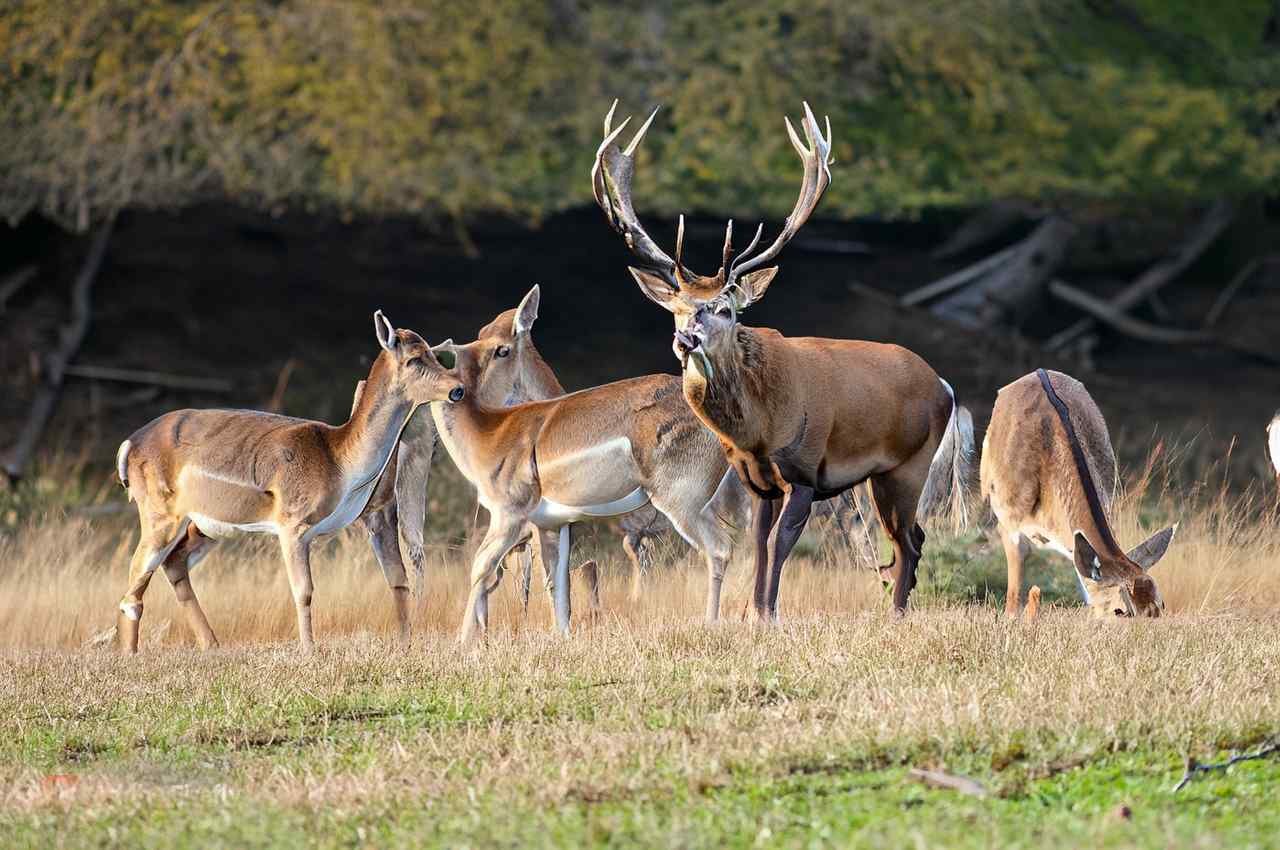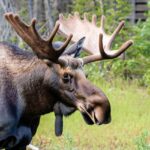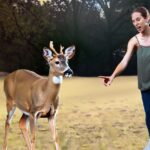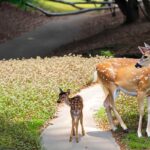Many wildlife enthusiasts eagerly anticipate when is deer mating season. The rut, or yearly deer mating season, is a thrilling time for both hunters and nature enthusiasts. Deer engage in intriguing activities at this time as bucks chase does and contend for breeding privileges. Learn more about the rut in the next paragraphs, including its causes and the peculiar ways that deer mate.
When is deer mating season?
The rut, commonly known as deer mating season, takes place in the fall, usually between September and November. Depending on the deer species and the area, the precise period of the rut varies. For instance, white-tailed deer often rut in the northern United States in October while doing so in the southern United States in November.
Male deer grow more violent and possessive during the rut. They will battle other males for the privilege to reproduce and mark their territory with urine and waste. Additionally, male deer will vocalize more during the rut, roaring and grunting loudly to entice females.
Usually between 24 and 36 hours, female deer are only receptive to mating for a brief period of time. A female deer will enter estrus again in roughly 28 days if she does not get pregnant during this period.
The gestation time for deer is around 6.5 months, or 200 days, after a buck and doe have mated. Fawns normally give birth in the spring, between April and June.
Deer numbers depend on the rut heavily. Deer breed throughout this season, ensuring the continuation of their species. The rut, though, may also be risky for deer. During the rut, male deer are more likely to be hurt or killed, and they are also more prone to be struck by cars.
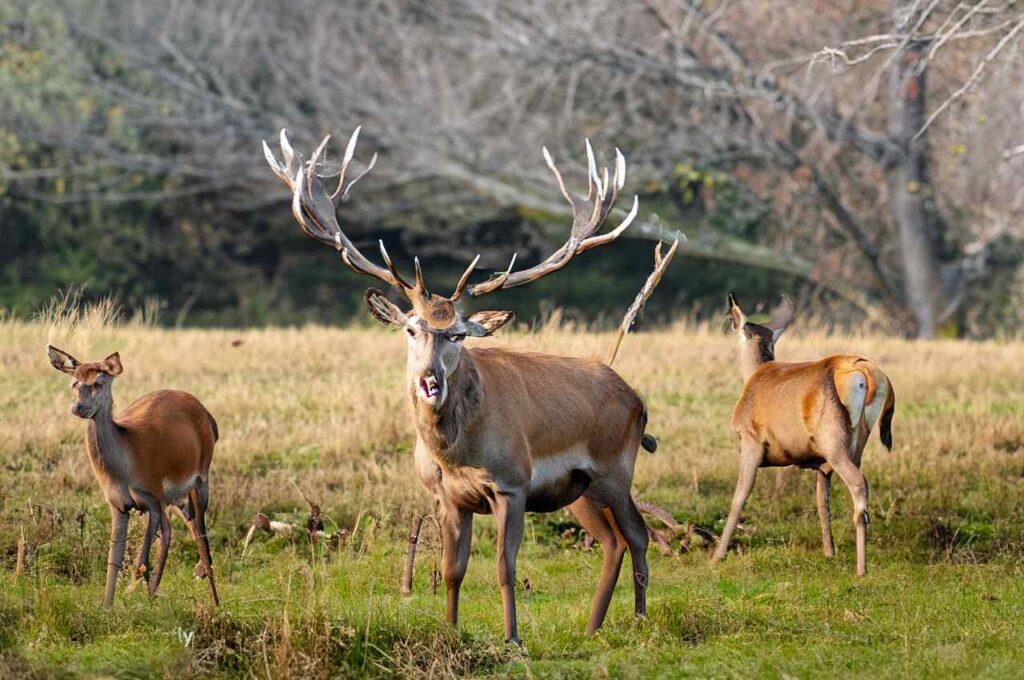
Deer Rut Timing Across Different Latitudes
The table below demonstrates how the time of the deer rut changes based on latitude and helps in understanding when to anticipate the mating season in various geographic locations.
| Latitude Range | Rut Timing |
|---|---|
| Northern Regions | September to October |
| Mid-Latitude Regions | October to November |
| Southern Regions | November to December |
Deer Mating Season by Species
| Deer Species | Mating Season Period |
|---|---|
| White-tailed Deer | Late September to Early December |
| Mule Deer | Late November to December |
| Red Deer | September to October |
| Fallow Deer | October to November |
| Roe Deer | July to August |
| Sika Deer | October to November |
Rut Phases and Deer Behavior
| Rut Phase | Key Behavioral Changes |
|---|---|
| Pre-Rut | Bucks establish territory and rubs |
| Chase Phase | Bucks chase receptive does |
| Peak Rut | Intense competition and mating |
| Post-Rut | Bucks may exhibit exhaustion |
| Post-Rut Recovery | Bucks recover, shed antlers |
Gestation Period and Fawn Birth Months
| Deer Species | Gestation Period (Days) | Fawn Birth Months |
|---|---|---|
| White-tailed Deer | Approximately 200 | April to June |
| Mule Deer | Approximately 200 | May to June |
| Red Deer | Approximately 234 | May to June |
| Fallow Deer | Approximately 234 | June to July |
| Roe Deer | Approximately 280 | June to July |
| Sika Deer | Approximately 234 | May to June |
Factors Influencing Deer Rut Timing
| Factors | Influence on Rut Timing |
|---|---|
| Photoperiod (Day Length) | Triggers the start of the rut with shorter days |
| Temperature | Indirectly influenced by cooler fall temperatures |
| Moon Phases | No scientific evidence to support moon's influence |
| Weather Conditions | Rut is primarily driven by photoperiod, not weather |
Deer Mating Season by States
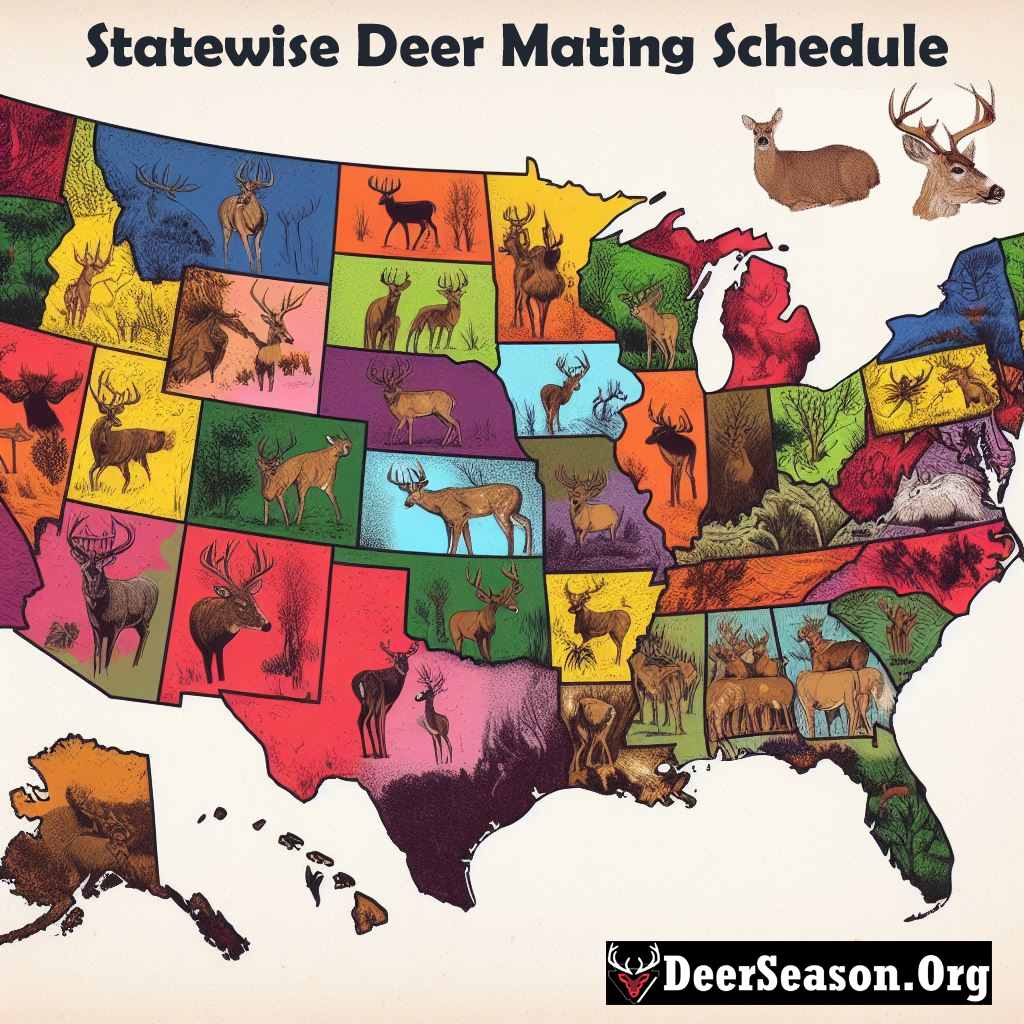
| State | Deer Mating Season |
|---|---|
| Alabama | October-November |
| Alaska | August-September |
| Arizona | September-October |
| Arkansas | October-November |
| California | August-November |
| Colorado | October |
| Connecticut | November-December |
| Delaware | November-December |
| Florida | September-December |
| Georgia | October-November |
| Hawaii | Not applicable |
| Idaho | October-November |
| Illinois | November-December |
| Indiana | November-December |
| Iowa | November-December |
| Kansas | November-December |
| Kentucky | October-November |
| Louisiana | September-November |
| Maine | November-December |
| Maryland | November-December |
| Massachusetts | November-December |
| Michigan | November-December |
| Minnesota | November-December |
| Mississippi | October-November |
| Missouri | November-December |
| Montana | October-November |
| Nebraska | November-December |
| Nevada | September-October |
| New Hampshire | November-December |
| New Jersey | November-December |
| New Mexico | September-October |
| New York | November-December |
| North Carolina | October-November |
| North Dakota | November-December |
| Ohio | November-December |
| Oklahoma | November-December |
| Oregon | September-October |
| Pennsylvania | November-December |
| Rhode Island | November-December |
| South Carolina | October-November |
| South Dakota | November-December |
| Tennessee | October-November |
| Texas | September-December |
| Utah | September-October |
| Vermont | November-December |
| Virginia | November-December |
| Washington | September-October |
| West Virginia | November-December |
| Wisconsin | November-December |
| Wyoming | September-October |
Everything You Need to Know About Deer Mating Season
| Aspect | Description |
|---|---|
| Timing of the Rut | • White-tailed deer: November to December, • Elk: mostly in September, White-tailed deer: October to December. |
| Triggers of the Rut | • Moon phases or environmental factors do not cause hormonal changes in deer; rather, photoperiod (daylight duration) does. |
| Role of Hormones | • Does go through hormonal changes as buck testosterone levels increase, causing behavioral changes and antler development. |
| Buck Behavior | • Bucks increase their activity and aggression. Use scent-marking to attract does and communicate. Participate in sparring contests. |
| Chasing and Courting | • Bucks go after does with vigor. Initial resistance is followed by a courtship phase, and successful bucks may mate with many does. |
| Vocalizations | • Bucks grunt and roar, and does bleat in response, indicating that they are ready for mating. |
| Scrapes and Rubs | • Bucks who have been scent-marked leave scratches. For territorial marking, deer rub their antlers against trees. |
| Does in Estrus | • During the rut, female deer go into estrus and release pheromones to entice possible mates. |
| Gestation Period | • Does normally give birth to fawns between 6-7 months later in the spring or early summer. |
| Hunting Opportunities | • Deer hunting is best during the rut because bucks are more active and less cautious at this time. |
Daylight and Deer Breeding: The Trigger for the Rut
The main cause of the rut is the shorter days of fall. Deer are “short day breeders,” which means that in the fall, shorter days and longer nights stimulate the desire to reproduce. On the other hand, “long day breeders” like horses, who go into heat in the spring and summer, are different.
Two significant changes occur in bucks and does as the days become shorter for deer:
- Bucks endure increased testosterone levels, antler growth, and aggressive inclinations.
- Do they begin their estrous cycle when they are fertile
Because of this synchronization, mating may take place in North America between October and December, when conditions are ideal. Latitude determines the precise date, with southern parts rutting later.
Myths Regarding the Rut
While the rut is caused by day length, several misconceptions contend that other reasons also contribute:
- Moon phases: There is no proof that the moon has an influence on breeding cycles.
- Cooler temperatures: The shift in the weather in the fall is a reflection of the shorter days.
- Weather variations: The rut is unaffected by rain, storms, or variations in barometric pressure.
The Peak of Rut: Chase and Competition
The peak of the rut is a frenzy of breeding and pursuing competition. Buck actions to attract a partner include:
• Tenacious trailing of estrous does
• Guarding a doe from other suitors
• Sparring battles with other mature bucks
• Breeding with multiple does over 24-36 hour estrous cycles
• Going days with little rest or food during peak rut
The “chase phase” is the period during which bucks chase every doe they come across. When two bucks are equally matched, competition may sometimes become lethal.
The Rut’s Final Stage: Exhaustion and Recovery
As the rut draws to a close, bucks get exhausted and reach their physical limitations. If DOES are not impregnated sooner, they often stay receptive and breed until December.
The procedure of recovering squandered money is time-consuming:
- Appetite and feeding gradually return
- Antlers are shed between January and March
- Return to bachelor groups by spring
Development and Early Survival of Fawns
Fawns are born 200 days after the rut as a result of breeding. Here is how fawns are created:
- Does breed multiple times to ensure pregnancy
- Most first-time does have one fawn; older does often have twins
- Fawns weigh 4-5 pounds at birth and can walk shortly after
- Mothers hide fawns to keep them scent-free from predators
- Young remain with does for one year as they mature
In the first few weeks after birth, fawns are particularly susceptible. Those that live until fall have a decent chance of maturing.
Success in the field and the Rut
Due of buck actions, the rut offers special possibilities for hunters:
- Travel further in quest of does
- Move around the clock rather than just at night
- Have reduced wariness and situational alertness
- Are less cautious when distracted by does.
Hunting during the rut has additional obligations:
- Adhere to doe harvest laws
- Follow fair chase guidelines
- Employ enhanced smell control techniques
Overall, ethical hunters have special responsibilities and possibilities during the rut.
Deer Communication and Mating Behaviors
During the rut, deer use a range of behaviors and communication techniques to locate partners and procreate. The deer mating process may be better understood by being aware of these strategies.
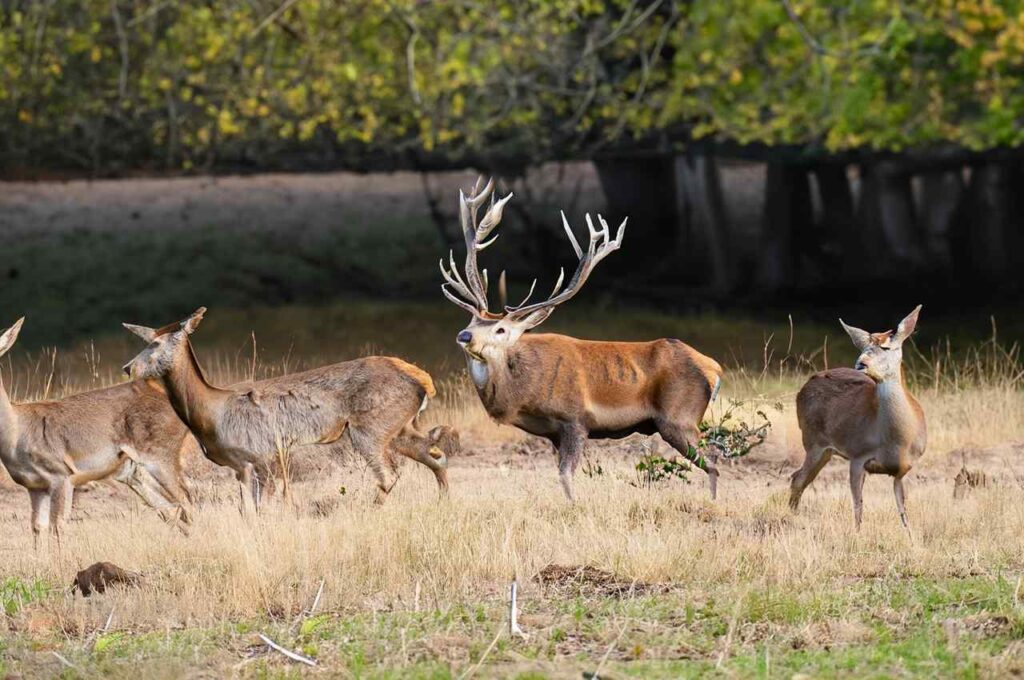
Sparring and Dominance Displays
Young males spar by locking antlers and pushing in strength tests long before the rut. Ahead of the rut, adult bucks perform shows of dominance:
Making scratches on the ground with urine and hoof pawing, marking territory by thrashing plants and young trees with antlers, leaving smell deposits on trees, and more
These actions build social standing and let other bucks know that you’re ready to go.
Vocalizations and Calling
| Vocalization | Meaning |
|---|---|
| Buck Grunts | Asserts dominance over other males |
| Snort-Wheezes | Signals warnings of danger |
| Roars or Bellows | Intimidates rivals during the rut |
| Bleats and Mews | Helps locate female deer |
Deer vocalizations communicate the following crucial messages:
- Buck grunts assert dominance over other males
- Snort-wheezes signal warnings of danger
- Roars or bellows intimidate rivals during the rut
- Bleats and mews help locate female deer
Age, stature, social standing, and purpose are all conveyed via each sound.
Deer Mating Season Safety Tips
Risks result from the rut’s unpredictable deer migration. For motorists, bikers, and pedestrians, caution is urged. Among some prudent safety advice are:
- Pay attention to deer that may sometimes cross highways, whether it is day or night.
- Go more slowly while passing through regions known to be home to deer
- If a deer comes, use heavy braking; do not swerve.
- If you see a deer, use your flashers to alert other cars.
- When deer are most active, at night and morning, drive more cautiously.
- Keep your focus and pay close attention to the side of the road.
Deer collisions may be decreased by taking extra precaution and monitoring the area ahead. The most dangerous accidents are usually caused by swerving, so if one must dart out quickly, avoid the desire. Authorities should be informed of any deer-vehicle crashes so that the animal may be taken off the roadways.
Frequently Asked Questions
How many times a year do deer mate?
Deer mate once a year during the breeding season, commonly referred to as the rut, which typically takes place between September and December. The rut is brought on by shorter days, which cause male deer (bucks) to have higher testosterone levels and female deer (does) to start going into estrus. Does have a short twenty-four-hour period of receptivity in November, and if mating has not taken place, a second estrus develops around 28 days later. Deer give birth to one or two fawns after a gestation period of around 6.5 months. The deer’s typical activity patterns resume after the lengthy mating season, during which bucks may mate with numerous does.
What period of the year is the deer breeding season?
The “rut,” also known as the deer mating season, lasts from late September to December, usually peaking in October. Depending on the area and the particular deer species, the season may vary; southern environments often experience mating season in January or February.
What are the signs of deer mating season?
Rubs and scratches are indications that it is deer mating season. Rubs happen when male bucks rub their antlers against bushes and trees to remove the velvet coating and leave a musky fragrance on their territory. Bucks munch on branches that dangle over open spaces, produce smell, and paw the ground to make scrapes, which are bare patches of ground.
How long does deer mating season last?
The height of the deer mating season usually occurs in October, and it lasts from late September until early December. The mating season, however, can continue into January or February in certain southern settings.
What is the peak of deer mating season?
Though the precise time may change based on the region and kind of deer, the height of the rut, or deer mating season, often happens around October.
What triggers deer mating season?
In late September, as fall draws closer, the deer breeding season is sparked by shorter daylight hours. The rut is a result of the deer’s physiological changes stimulated by this shift in photoperiod.
How do male deer compete during mating season?
During the mating season, male deer, or bucks, compete by participating in sparring contests with other males to gain supremacy. Along with pursuing receptive does, they brush and scratch their area to indicate it. Bucks may consume less food and become more active at this period, utilizing their stored energy for mating.
What is the breeding season for white-tailed deer in Maryland?
In Maryland, the white-tailed deer mating season normally lasts from late October until mid-December. The reduction in daylight hours (photoperiod) marks the beginning of mating season. The majority of pregnancies do occur in the first part of November.
When does the rut occur in Pennsylvania?
In Pennsylvania, the rut starts in the middle of November, peaking around that time. The rut season typically starts in the middle of September and lasts through early to mid-October, peaking in mid-November, according on breeding date information from does that were killed on the road in the state.
What is the primary breeding season for most deer species?
For the majority of deer species, including white-tailed deer, the main mating season lasts from late September to December. The rut sets in during this time, brought on the shorter daylight hours.
When is the most active time of year for deer?
The rut, which normally lasts from late September through December, is when deer are most active. Deer are quite busy at this time, engaged in activities connected to mating, and may be easier to see at dawn and dusk.
Conclusion
The mating season normally lasts from September through November during the fall season. As they compete for the chance to mate with receptive females, or does, male deer, known as bucks, experience extraordinary behavioral changes, becoming more aggressive and territorial. These does attract bucks through pheromones and scent marking during their brief 24- to 36-hour estrus period. Deer have a gestation period of around 6.5 months after a successful mating, with fawns normally being born in the spring between April and June. The rut plays a crucial role in the deer’s life cycle and maintains the species’ viability.
- California Deer Hunting Guide: Seasons, Rules, Permits, and More - 26 June 2024
- Arkansas Deer Season 2024 [Schedules, Licenses, Bag Limits & More!] - 26 June 2024
- 2024 Arizona Deer Season New Dates & Rules! - 25 June 2024
